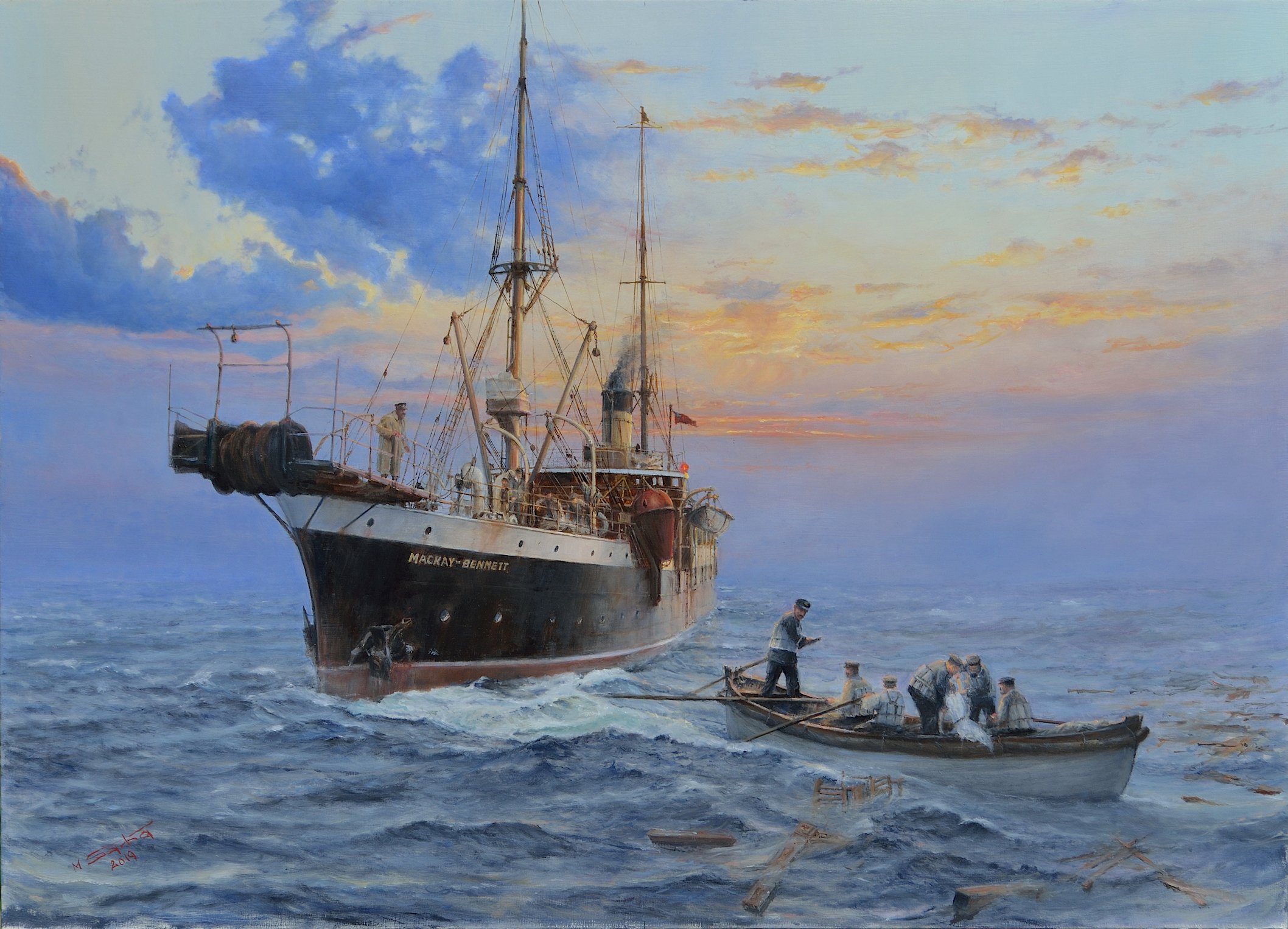The Requiem: The Recovery of the RMS Titanic, April 14, 1912
oil on panel, 20” x 28”
$18,500
On April 14, 1912, 375 miles south of Newfoundland the largest ship afloat RMS “Titanic” at 11:40 p.m. (ships time) hit the iceberg. The collision caused the hull plates to buckle inwards along her starboard and opened her compartments to the sea. At 2:20 a.m. on 15 of April 1912 she broke apart and foundered with well over one thousand people still aboard. The White Star Lines (ship owner) chartered the Commercial Cable Company’s cable ship C.S.”Mackay-Bennett for a difficult assignment: to search thoroughly the area where “Titanic” sunk and, whenever possible, to recover the bodies of passengers and crew. White Star agents contracted with John Snow and Co. Ltd. the province’s largest undertaking firm which asked and received the assistance of nearly every embalmer in Nova Scotia.
On Wednesday 17 April at 12:35p.m. C.S.”Mackay-Bennet” filled with tons of ice, over 100 coffins and more than 40 members of the Funeral Directors Association of the Maritime Provinces departed from home port Halifax, Nova Scotia. Soon a message came from German liner “Rhein” and giving position to the effect that they had passed wreckage and bodies. As “Mackay-Bennett” made for this position next ship, liner “Bremen” reported three large icebergs and bodies from similar location. “Mackay-Bennet” arrived in the area at 8pm on Saturday, too late to begin searching and ship stopped and drifted. At daylight, the “Mackay-Bennett’s” boats were lowered and in spite of the heavy seas, 51 bodies was recovered. At 5 p.m. the day’s work ended with the end of daylight and boats were hauled back aboard. John Snow and his assistants embalmed twenty bodies, a further six being left for the following morning. At 8:15 p.m. conducted a burial service on the forecastle deck of 24 bodies, mostly of crew, none identified.
Sunday, 21 April was observed as a day of rest and remembrance aboard the ship. Recovery operations resumed at 5:30 a.m. on Monday morning, amid a large quantity of wreckage. The ship recovered 27 bodies, Colonel John Jacob Astor among them. After steaming for nineteen miles in and out of line wreckage “Mackay-Bennett” came additional victims as light was fading. A buoy was dropped to mark the spot where tomorrow’s work would begin.The Saturday had another sea burial of fifteen bodies. Some reports from passing by ships directed ship to other places recovering additional bodies. At 4:30 a.m on Thursday, yet another body was found, a prelude to what was to be a most arduous day for the ship's crew. During the fourteen hours that followed, 87 additional victims were recovered, searched and tagged next. By this point, supplies had begun to run critically low and the capital sent a message for more supplies and information that all bodies not embalmed will be buried at sea.
On Friday additional steamship C.S.”Minia” arrived at the disaster site with additional supplies including 150 coffin.s, Mackay- Bennett’s” crew had found 306 bodies, of which 116 had been buried at sea. At 9:30 a.m on Tuesday, 30 April, the “Mackay-Bennett entered port of Halifax with 190 bodies. She slowly steamed, her mainmast flag fluttering at half-staff. The harbor, usually full of life, was silent and empty.
Many named C.S. Mackay-Bennet” as “The Ship of Death.” On the painting: End of the day. One from the rescue boats returning to the ship for night. Crew pulling the Titanic last victim of the day from the sea. On the forecastle deck of “Mackay-Bennett” preparations for the sea burial.

